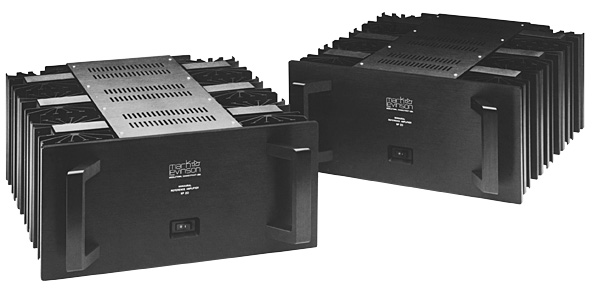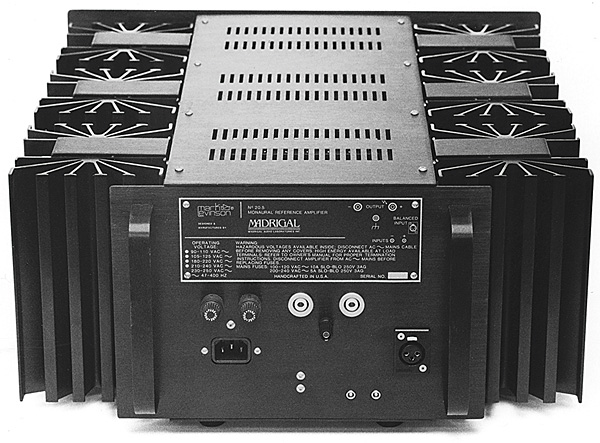Mark Levinson flagships Page 2
Preamp Design
A new-generation product, the No26 is an all-discrete dual-mono unit, with separated circuits and power supplies for each channel. It features selected, DC-controlled relays for switching the audio circuit, which allows the switches to be positioned according to the principle of the shortest signal path. The double power supplies are located outside the preamp case, and are double-filtered before arriving at the No26 (or No25).

Specially Designed Discrete
Class A regulators are used for each stage and each channel, while thermal tracking compensation has been included in the active circuits to aid warm-up. The line-output amplifier is not truly differential – rather, the negative signal phase is produced via an additional inverter stage. Madrigal Labs carefully balances the signals to achieve a good common mode rejection. While some boards are modular, care has been taken to use high performance professional connectors. The level control is specially made by Penny & Giles in the UK, reputed to build the best conductive plastic potentiometers.
Sound Quality
The analogue source used for the listening was my trusty Goldmund Studio-ST4 turntable combination, with Koetsu RS cartridge. Digital replay came from both a Meridian 208 and a Wadia 1000 decoder. As for the main loudspeakers, these were Apogee Duetta Signatures, supplemented by MartinLogan Sequel IIs, the Celestion SL700 and Spendor SP2-2.
My listening extended over several days and encompassed most of my review recordings as well as many others. Overall, I was left with the impression that this Levinson amplifier system was capable of providing a high degree of listener satisfaction.
Finely developed and refined, it had no significant bugs, and no obvious weaknesses to disturb a listener's equilibrium. Rather than invite a premature assessment of sound quality with a critical, even jaundiced eye (ear!), the Levinson system allows the listener to relax and enjoy the music, forgetting the mechanics of audio reproduction.
The Levinsons are not 'enthusiast' products of the sort designed to satisfy owners seeking a quick thrill or a startling burst of excitement. Rather, they give the impression of a refined calmness, a trustworthy character, a sonic consistency which is maintained over long periods.
While there are difficulties and dangers in 'breaking up' the Levinson system for analysis, I did seek evidence for further discussion by separating out the 20.5 power amplifiers. Without doubt, these were of reference quality, clearly placed in the territory occupied by the current top performers. Although in my opinion not the best of these, the 20.5 had a certain kind of stability and solidity, not specifically in the bass I might add, but a solidity comprising a clear virtue in its own right and not exhibited so well by the others.
This virtue, I believe, may be accredited to the massive regulated power supplies. This was clearly a high-performance design, notwithstanding a mildly 'old fashioned' flavour to the sound. Compared with the most neutral of today's performers, indeed to an unobtainable synthesis of the best aspects of several modern designs, the 20.5 had distinct if mild tonal-balance and coloration errors in the bass, mid and treble ranges. Rather than single out these particular observations here, they will emerge in the overall analysis that follows.
From the outset the 20.5's stereo staging was impressive, and the amplifier was very successful in describing width, height, scale and perspective in the stereo image. The sound was strong and authoritative, with stereo focus close to excellent. Stage width was more impressive than depth, the latter a mite veiled and closed-in; 'darker' is perhaps a fairer description, since the inherent transparency was more than sufficient for high levels of musical detail to be reproduced.
Meanwhile, bass lines were powerful and extended. 'Walking' bass tunes were presented with great evenness and authority, while the amp was capable of powerful bass slam, with no suspicion of that light-dimming momentary exhaustion felt with some smaller amplifiers on heavy bass sections.

Conversely, the bass was a touch slow as well as boxy – not quite as crisp and open as other references show to be possible. As regards tonal balance, the upper midrange – the high end of the violin spectrum – was perceptibly leaner, 'whitened' as some US critics might put it. Certainly this range seemed projected forward to some degree. Finally, in the treble there was a touch of old-fashioned 'grain', though this was very well controlled.
Thrills With No Spills
These mildest of flaws do not detract significantly from the remaining strengths, which have to do with the vivid, articulate midrange, and the effective way in which the power and excitement of a musical performance are presented. There was nothing slow about the overall sound, which showed excellent precision, particularly with piano and vocal.
Trials were made with balanced and unbalanced drive. From a Levinson source, unbalanced drive resulted in a very slight loss in low-level detail, plus a proportionately greater loss of both bass dynamics and definition. The 20.5 had very good dynamics, with the ability to play with complete confidence over a wide range of sound levels despite use with some of the most difficult loadings. And in this latter context I am including the MartinLogan Sequel II loudspeakers. Conversely, the 20.5 did not shine particularly brightly in the drive and rhythm department, this deficiency being more obvious on complex percussion programme.
Moving on to the No26 preamp used with the No25 phono stage, this was employed in balanced output mode but with unbalanced inputs, as no really good balanced sources were available. Noteworthy was the excellent consistency heard between the line and disc input sections. Good preamps ought to have neutral, self-effacing disc inputs, but many do not. From the outset it was clear that the No25/26 was eminently compatible with the No20.5, complementing it very well and helping to create a well-balanced musical whole.
State Of The Art?
Neutrality was a keynote with the No26. The tonal balance was even, the overall result sweet, and almost creamy in texture. As with the No20.5 power amp, stage width, depth, focus and perspective were merely a notch behind the very best. A touch more broad-band precision of focus would have been welcome, and while the transparency set a good standard I missed some of the far-space detail known to be present on some recordings. The No25/26 was highly listenable, yet stopped just short of delivering the full measure of depth and excitement. Its approach is best described as more considered than enthusiastic.

It is important to find a perspective for the assessment of this system. The parts work very well together, including the worthy Madrigal HPC cable set provided for the review. Costing some £20,000 for the complete system, this was close to the maximum ever considered on these pages for a stereo amplifier. Is the No25/26/20.5 combination state of the art? If judged on grounds of absolute sound quality, in my opinion it comes close, but does not quite attain these dizzy heights.
Rock And Rolls
But this is not the whole story. When making an investment such as this – and at this price level it must surely be regarded as an investment – one has to weigh up other aspects, such as its virtual indestructability, its sonic consistency and imperturbability, its versatile input and output matching arrangements, its proven longevity and maintained worth.
In addition, consider that the components come with a five-year warranty and that the modular construction allows for a degree of future updating, and easy serviceability. The components used are conservatively rated for a very long operating life, while the build philosophy is closer to a Mercedes or a Rolls than to a Ferrari or a Maserati, with a character to match.
I can certainly recommend this top-line Levinson amplifier system, but at this level only you can make the final choice.
























































